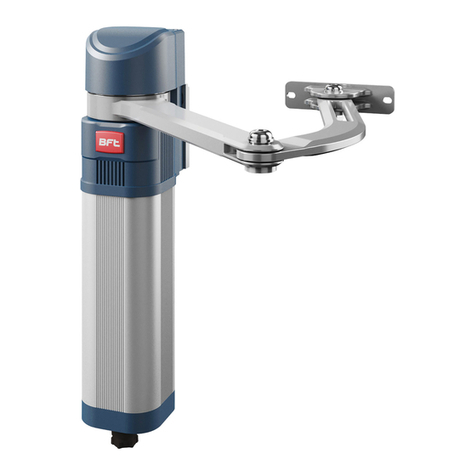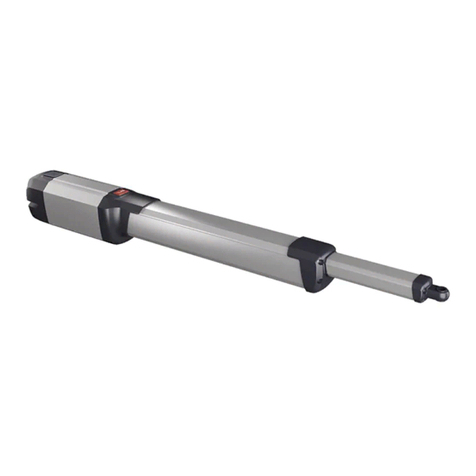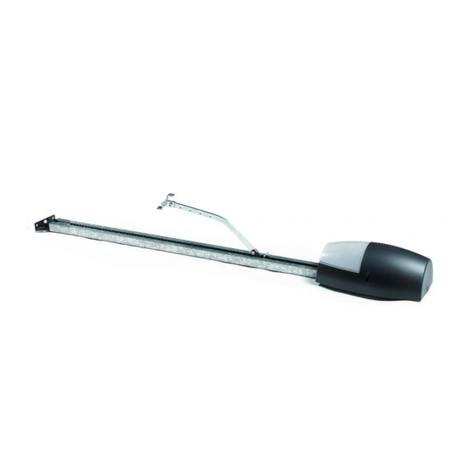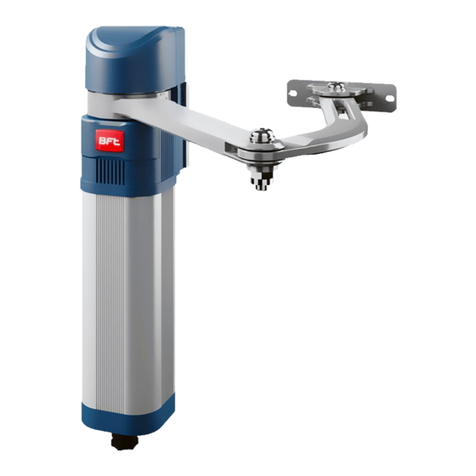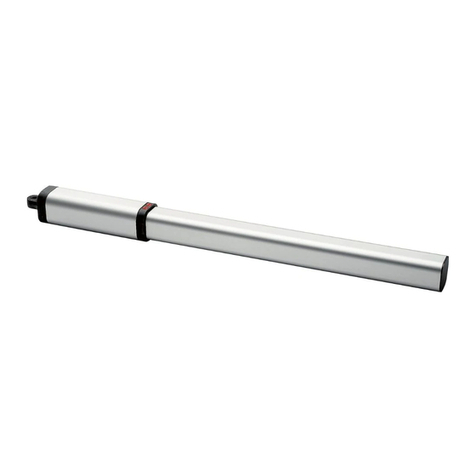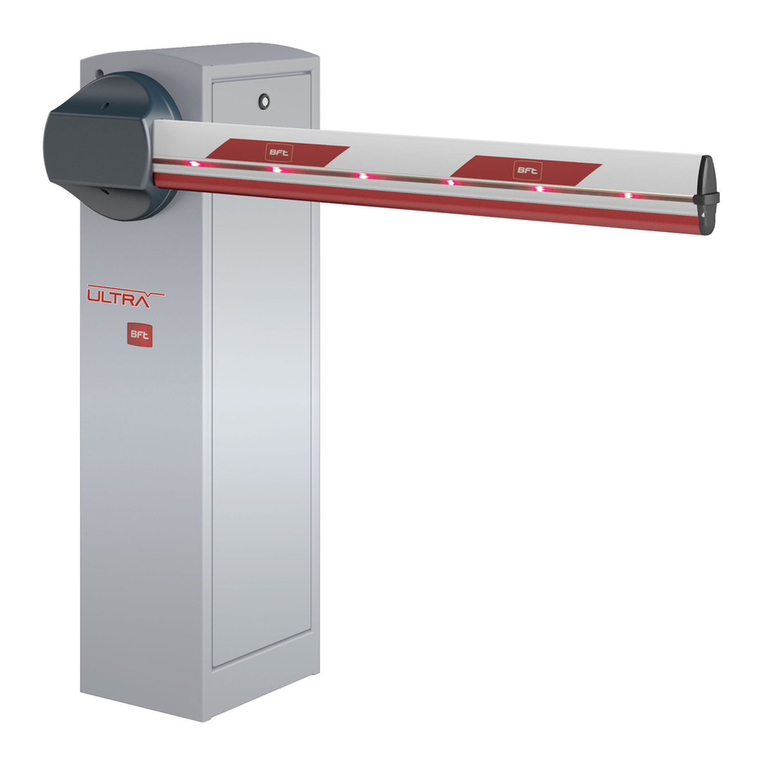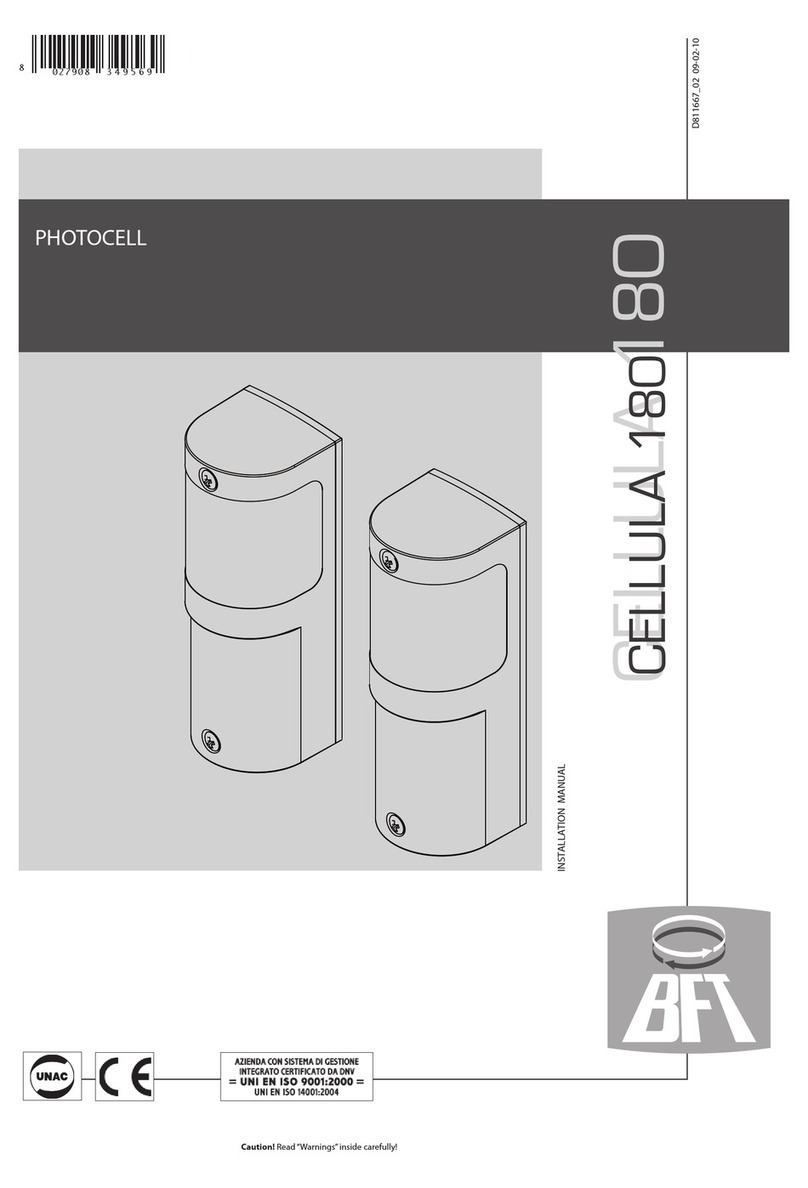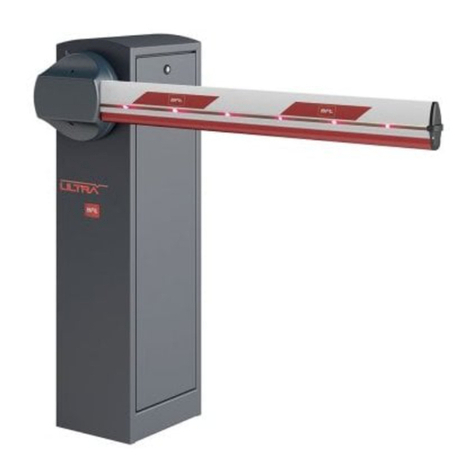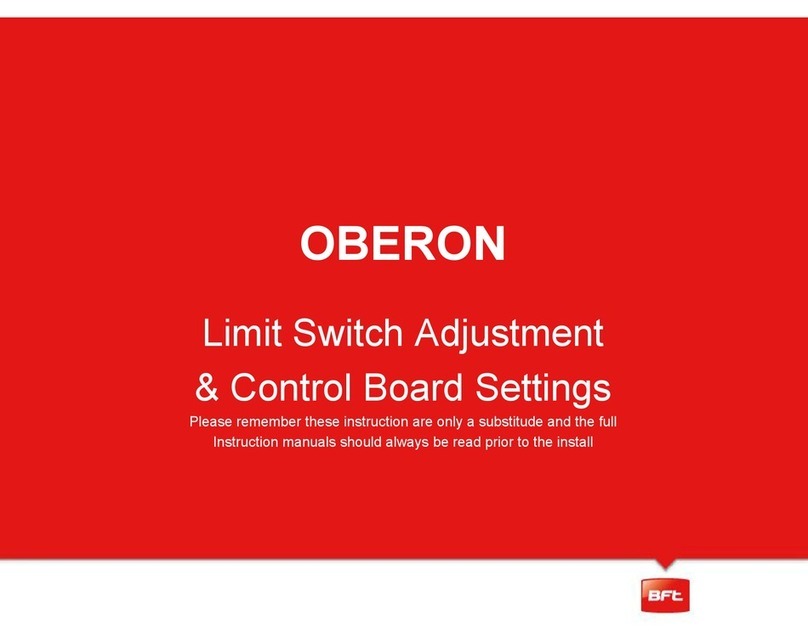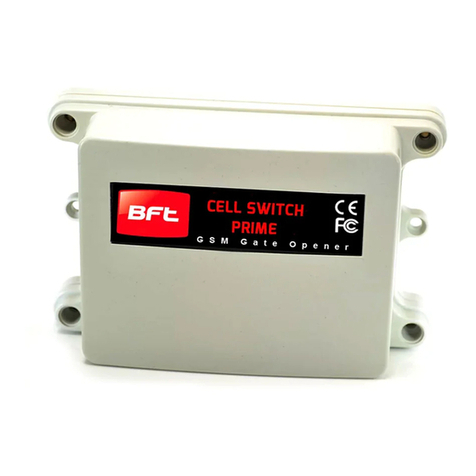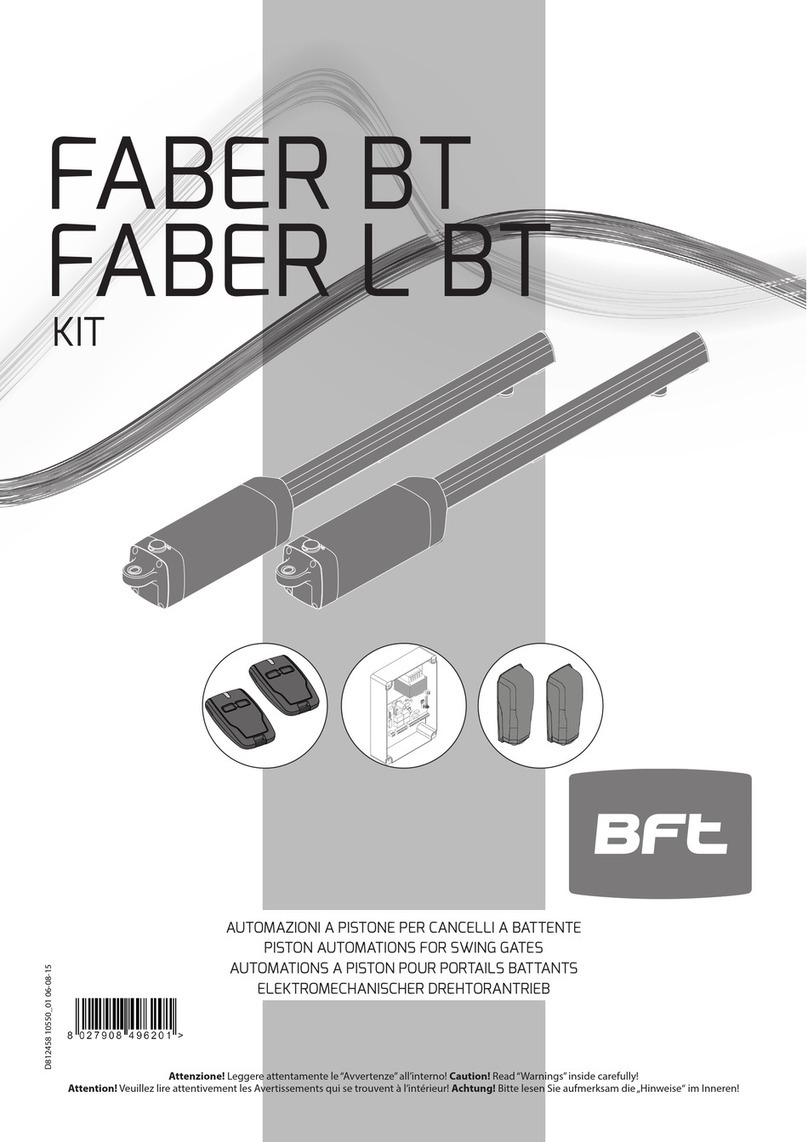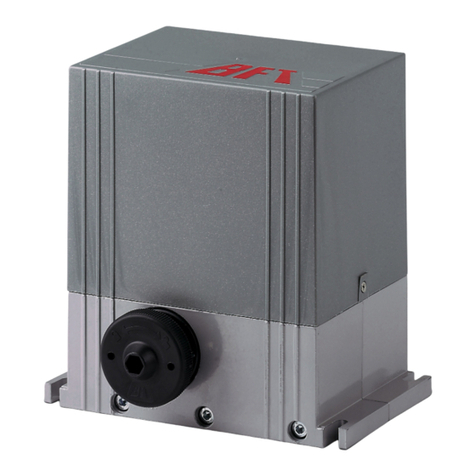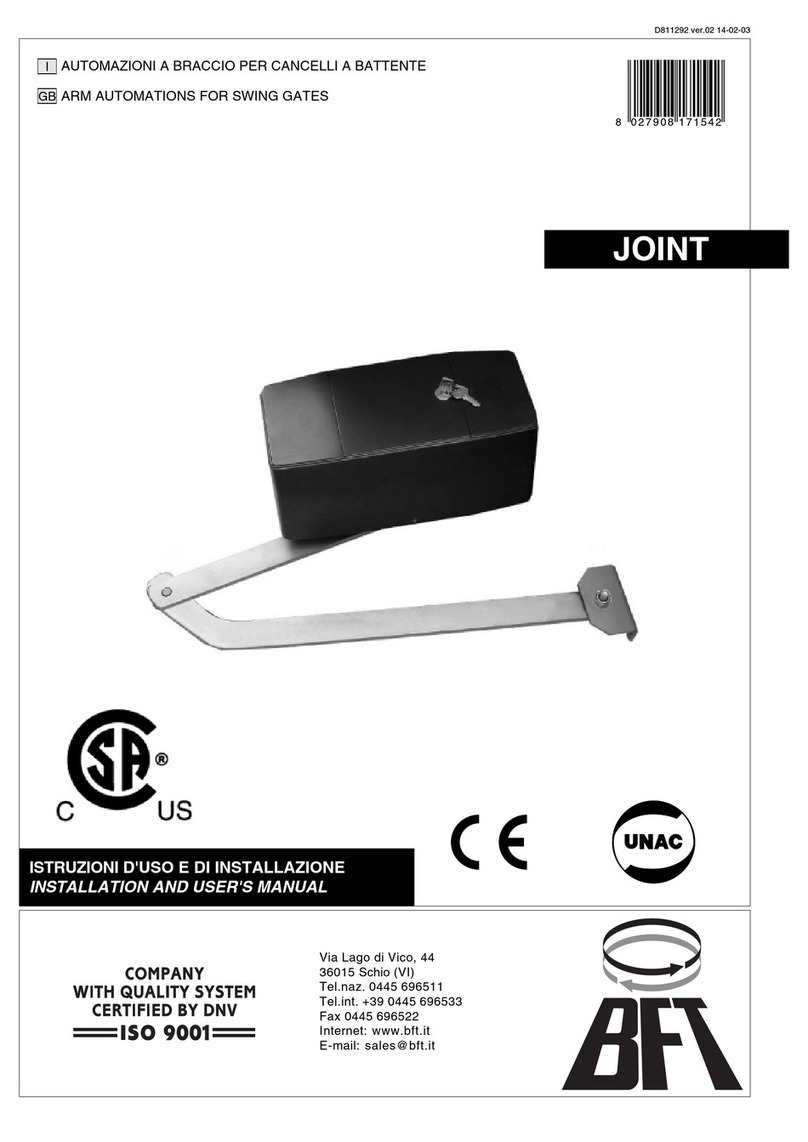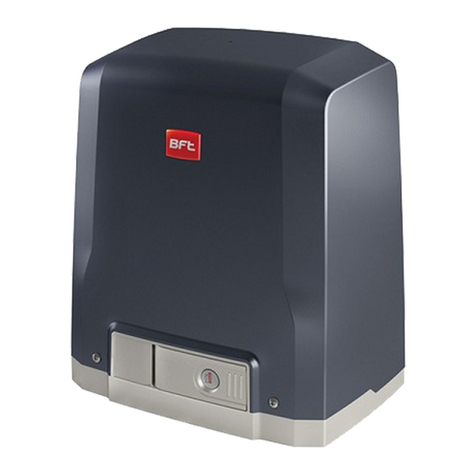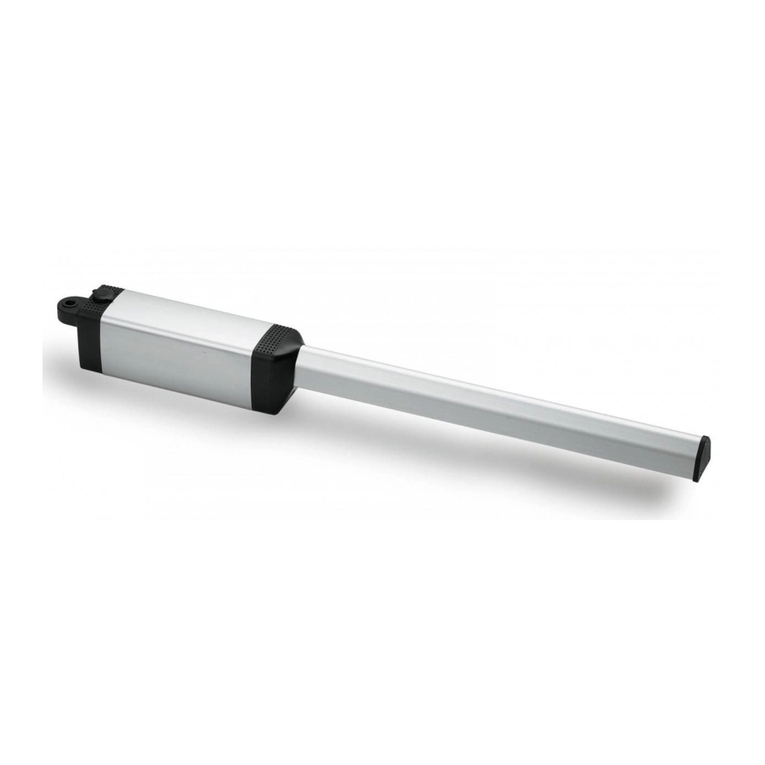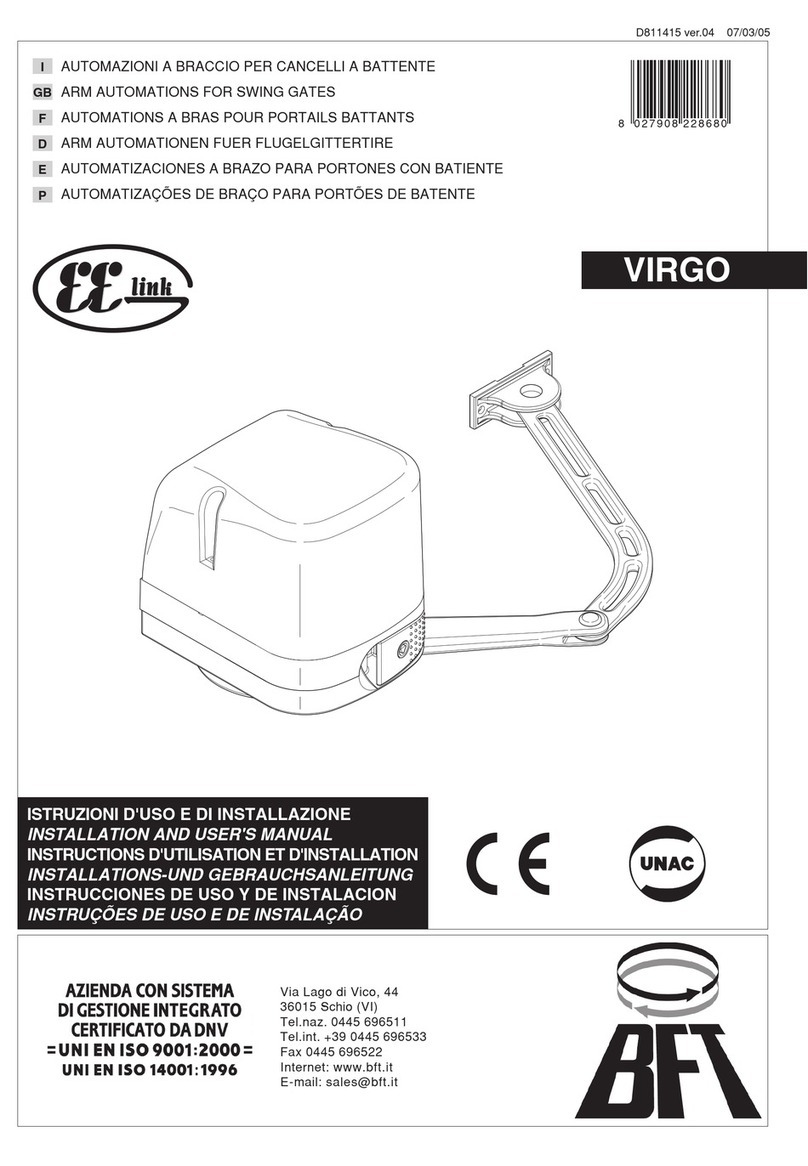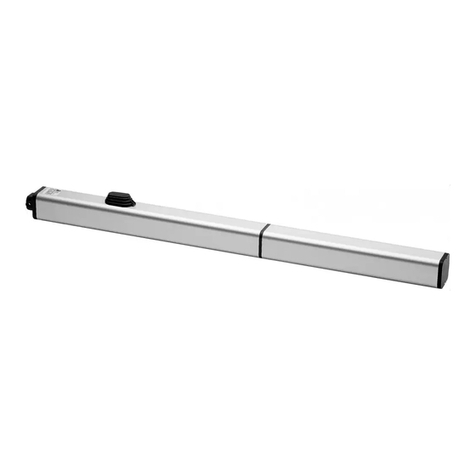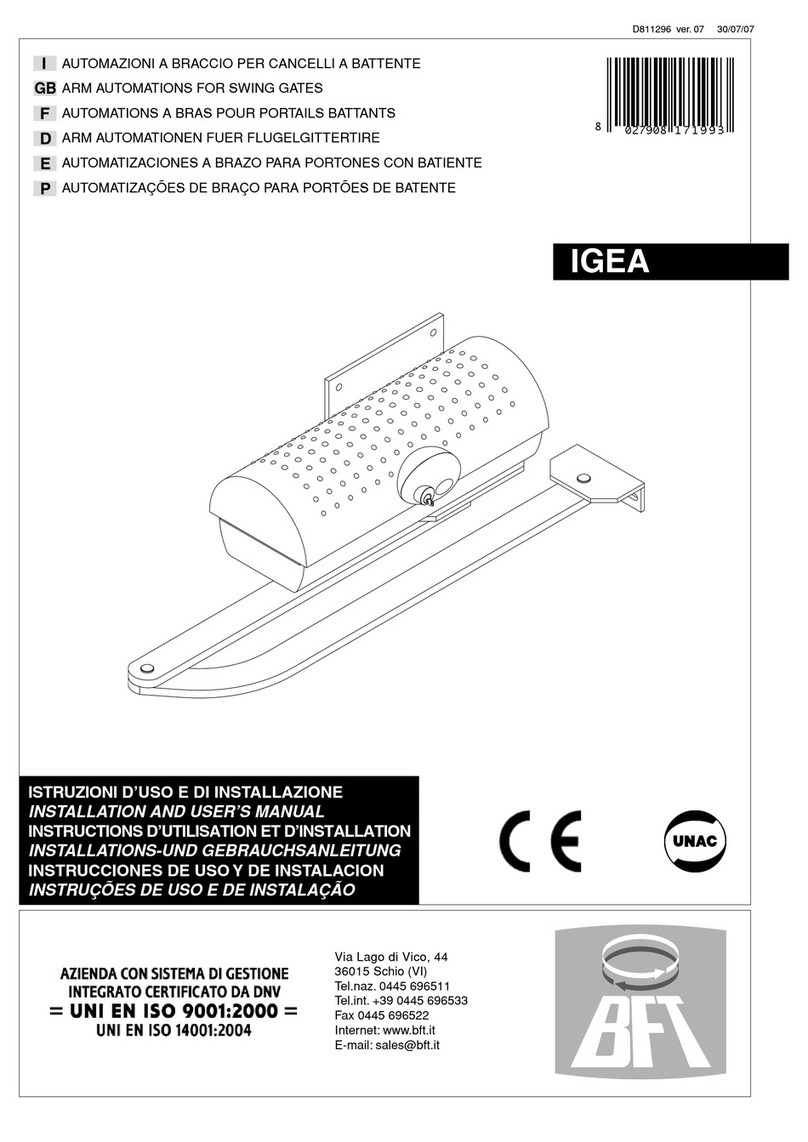MANUALE PER L’INSTALLAZIONE ITALIANO
• Tutte le aperture di un cancello a scorrimento orizzontale sono riparate o
schermate dal basso fino ad un minimo di 4 piedi (1,2 m) da terra, onde
prevenire che un oggetto sferico dal diametro di 2-1/4 pollici (57,15 mm) passi
attraverso le aperture in qualsiasi punto del cancello e in quella porzione della
recinzione adiacente coperta dal cancello stesso in posizione di apertura;
• Tutti i punti di pinzatura esposti risultano eliminati o riparati ed esistono
dei ripari per i rulli esposti.
• Sottoporre a prova l’azionamento per cancelli una volta al mese.Il cancello
DEVE eseguire la corsa inversa (marcia indietro) quando entra in contatto
con un oggetto rigido oppure arrestarsi quando un oggetto attiva i sensori
anticontatto. Se l’azionamento del cancello non funziona correttamente,
avvalersi di un tecnico specializzato nella manutenzione per far regolare
la coppia del motore o il limite della corsa e quindi eseguire una nuova
prova dell’azionamento.
In caso di mancata prova di riscontro o qualora le regolazioni dell’azio-
namento necessarie al suo corretto funzionamento non fossero eseguite
risulterà maggiore il rischio di lesioni o di morte.
• Utilizzare lo sblocco di emergenza solamente quando il cancello non è in
movimento.
• ESEGUIRE UN’ADEGUATA MANUTENZIONE DEI CANCELLI. Leggere
il manuale per l’utilizzatore. Avvalersi di personale specializzato nella
manutenzionepereseguireeventualiriparazioni suicomponenti meccanici
in metallo del cancello.
• L’entrata è riservata ai veicoli. I pedoni devono utilizzare un accesso
separato.
• CONSERVARE LE PRESENTI ISTRUZIONI.
3) DATI TECNICI
3.1) Attuatore DEIMOS BT UL
Alimentazione: ...........................................monofase 120V ±10% 60Hz (*)
Motore:.............................................................................................. 24V
Giri motore:.................................................................................. 3500min-1
Potenza assorbita:............................................................................... 70W
Corrente assorbita max: .................................. 0,5A (120V~) - 1A (110V~)
Rapporto di riduzione: ......................................................................... 1/44
Giri in uscita: ....................................................................................79min-1
Modulo pignone:......................................................0,157”( 4mm (14 denti)
Velocità anta: ..................................................................... 7,87”/s (0,2 m/s)
Peso anta max: .................................................1102,3 lb (5000N (≈500kg)
Coppia max: ..................................................................14,747 lb ft (20Nm)
Reazione all’urto: ........................................Limitatore di coppia elettronico
Lubrificazione: .............................................................Grasso permanente
Manovra manuale:.................................... Sblocco meccanico a manopola
N° manovre in 24 ore:.............................................................................. 30
Centralina di controllo: .............................................................. incorporata
Batterie tampone (opzionali): ..................................2 batterie da12V 1,2Ah
Condizioni ambientali: ..................................................... da -15°C a +40°C
Grado di protezione: ............................................................................IP24
Rumorosità: .................................................................................... <70dBA
Peso operatore: ........................................................... 15,4 lb (7kg (≈70N))
Dimensioni : ..................................................................................Vedi fig.2
Classe azionamento cancello................................................................. I, II
(*) Tensioni speciali di alimentazione a richiesta
3.2) Dati tecnici quadro di comando QSC-D UL (Fig.17)
Alimentazione accessori: ....................................................24V~(180 mA)
Regolazione amperostop: .........................................in chiusura e apertura
Tempo di chiusura automatica: .................................................da 3 a 120s
Tempo di lavoro:.................................................................................. 2 min
Tempo di apertura pedonale: .......................................................... 5s fisso
Pausa inversione: ..............................................................................c.a.1s
Collegamento lampeggiante:................................................ 24V max 25W
Fusibili:........................................................................................ Vedi fig.17
Impostazione parametri e opzioni:...............................................................
......................tramite display LCD o programmatore palmare universale
Radioricevente Rolling-Code incorporata:............... frequenza 433.92MHz
Codice a mezzo: ........Algoritmo Rolling-Code con clonazione trasmettitori
N° combinazioni:........................................................................... 4 miliardi
Impedenza antenna:........................................................... 50Ohm (RG58)
N° max. radiocomandi memorizzabili: ..................................................... 64
3.3) Versioni trasmettitori utilizzabili:
Tutti i trasmettitori ROLLING CODE compatibili con .
4) VERIFICHE PRELIMINARI
Prima di procedere a qualsiasi operazione di installazione, verificare che la
struttura del cancello sia conforme a quanto richiesto dalle norme vigenti
ed in particolare:
• Che il binario di scorrimento del cancello sia lineare, orizzontale e le ruote
idonee a sopportare il peso del cancello.
•
Cheilcancello possaesseremossomanualmenteinmodoagevole pertutta
la sua corsa e che non si verifichino eccessivi sbandamenti laterali.
• Chela guida superiorepermetta ilgiusto giococon il cancelloper garantire
un movimento regolare e silenzioso.
• Che siano posizionate le battute di arresto in apertura e chiusura.
• Che la posizione stabilita per il fissaggio del motoriduttore, consenta di
eseguire la manovra di emergenza in modo agevole e sicuro. Nel caso
gli elementi verificati non soddisfino quanto sopra descritto, procedere
alla loro sistemazione o, se necessario, allo loro sostituzione.
ATTENZIONE: Ricordarsi che la motorizzazione è una facilitazione del-
l’uso del cancello e non risolve problemi dovuti a difetti e deficienze di
installazione o di mancata manutenzione del cancello stesso.
Togliere il prodotto dall’imballo e verificarne l’integrità. Se il prodotto non è
integro, rivolgersi alpropriorivenditore.Ricordarsidismaltirei suoi componenti
(cartone, polistirolo, nylon, ecc.) secondo le disposizioni delle norme vigenti.
5) ANCORAGGIO DELLA PIASTRA BASE
5.1) Posizione standard
• Predisporre uno scavo dove eseguire la piazzola di cemento con annegati
i tirafondi della piastra base per il fissaggio del gruppo riduttore (fig.3).
Se il binario di scorrimento è già esistente, lo scavo deve essere ricavato
in parte anche nel getto di fondazione del binario. In questo modo, un
eventuale cedimento del getto di fondazione del binario farà abbassare
anche la base del motoriduttore mantenendo così il gioco tra pignone e
cremagliera (circa 1-2mm).
• Posizionare la piastra base rispettando le quote riportate in fig.4.
Il simbolo del pignone stampigliato nella piastra base deve essere visibile
ed orientato verso il cancello. Ciò garantisce anche la corretta posizione
delle canalette per i collegamenti elettrici.
• Lasciare i tubi flessibili previsti per il passaggio dei collegamenti elettrici
sporgenti dalla piastra base.
• Per mantenere in posizione corretta la piastra base durante la posa in
opera, può risultare utile saldare due piatti di ferro sotto il binario sui quali
poi, saldare i tirafondi (fig.3).
• Eseguire un getto di calcestruzzo, facendo in modo che il getto della
piastra base faccia corpo unico con quello del binario del cancello.
• Controllare accuratamente:
Le quote di posizionamento.
Che la piastra base sia ben livellata.
Che i 4 filetti dei prigionieri siano ben puliti dal cemento.
Lasciare rapprendere il getto.
5.2) Altre posizioni
Il motoriduttore può essere posizionato in diversi modi. A titolo di esempio,
in fig.5 è rappresentato un tipo di installazione particolare. Nel caso il mo-
toriduttore non venga fissato a livello del binario di scorrimento (Posizione
standard),sidevegarantireun sicurofissaggio delmotoriduttore inrelazione
anche alla posizione del cancello, in modo da mantenere un corretto gioco
0,039”-0,078”(1-2mm) tra cremagliera e pignone. Deve essere garantito il
rispetto delle norme di sicurezza vigenti per quanto riguarda le persone,
animali e cose, e in particolare devono essere evitati rischi di infortuni dovuti
a schiacciamento, nella zona di ingranamento pignone - cremagliera ed altri
rischi meccanici.
Tutti i punti critici dovranno essere protetti da dispositivi
di sicurezza secondo quanto prevedono le normative vigenti
.
6) FISSAGGIO MOTORIDUTTORE
Quando il getto è indurito, osservando la fig.6 procedere come segue:
• Posizionare un dado M10 in ognuno dei tiranti mantenendo una distan-
za dalla base di almeno 0,098” (25mm) per permettere di abbassare il
motoriduttore ad installazione ultimata o per aggiustamenti successi del
gioco tra pignone e cremagliera.
• Posizionare un piatto “P”in dotazione in ogni coppia di tiranti e con l’ausilio
di una livella, regolare il piano nei due sensi.
• Togliereilcofanoedilcartercoprivitialmotoriduttore,eposizionareilgruppo
riduttore nei quattro tiranti con il pignone rivolto verso il cancello.
• Posizionare le quattro rondelle e avvitare i quattro dadi di bloccaggio del
motoriduttore.
• Regolare la profondità del motoriduttore facendolo scorrere nelle apposite
feritoieprevistenellabase efissarlo aduna distanzatrapignonee cancello
adeguata al tipo di cremagliera da installare. I denti della cremagliera
devono ingranare nel pignone per tutta la loro larghezza.
Al paragrafo “Montaggio della cremagliera” riportiamo le misure ed il
modo di installazione dei tipi più diffusi di cremagliera.
7) MONTAGGIO DELLA CREMAGLIERA
Al cancello, deve essere fissata una cremagliera con modulo denti 13,1
ft(m=4). Per quanto riguarda la lunghezza, questa deve contemplare, oltre
alla luce del passaggio, anche il fissaggio delle staffe per l’azionamento dei
micro finecorsa e la parte di ingranamento del pignone.Esistono diversi tipi di
cremagliera, ognunodeiqualisidiversificaperla portataedilmododi fissaggio
al cancello. La Ditta commercializza tre tipi di cremagliera che sono:
7.1) Mod. CFZ (Fig.8).
Cremaglieradiferrozincatosez.0,866”x0,866”(22x22mm)- fornitain pezzi da
DEIMOS BT UL Ver. 07 - 5
D811419_07






